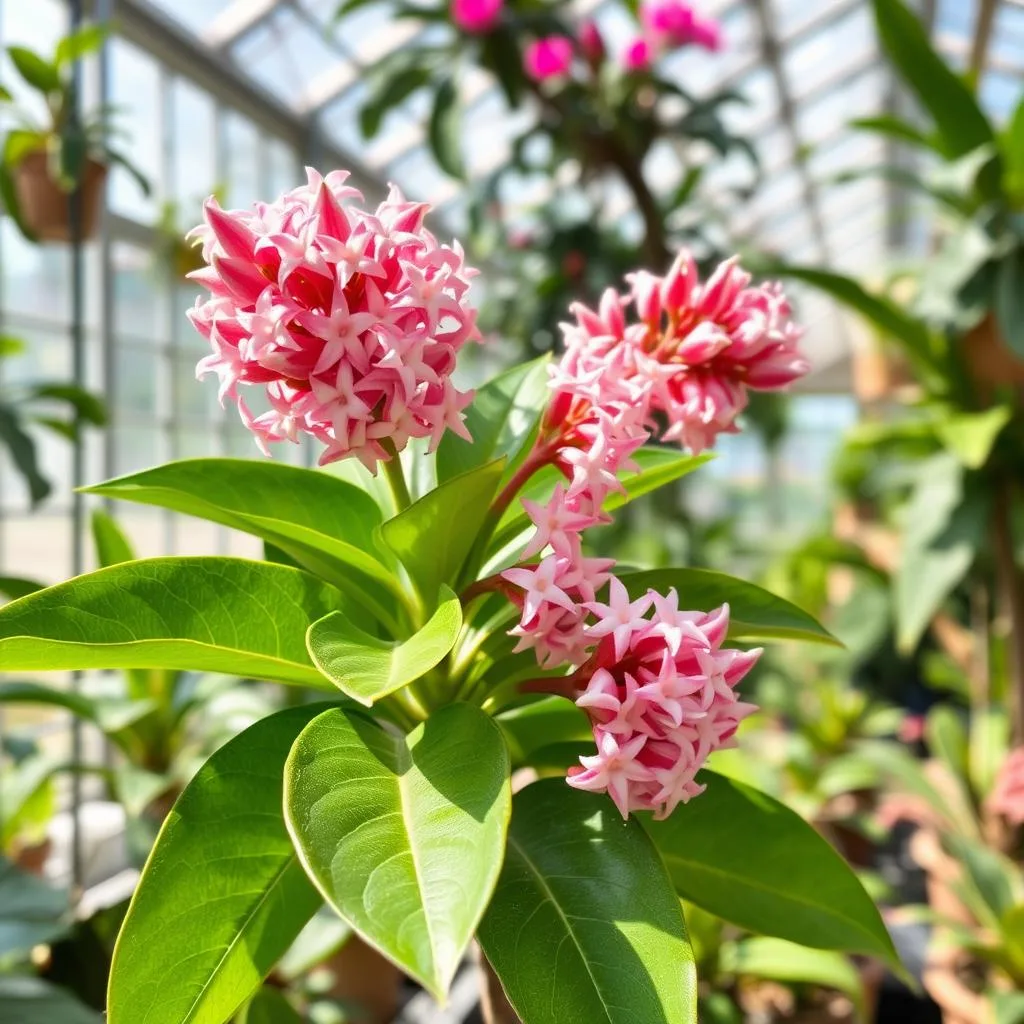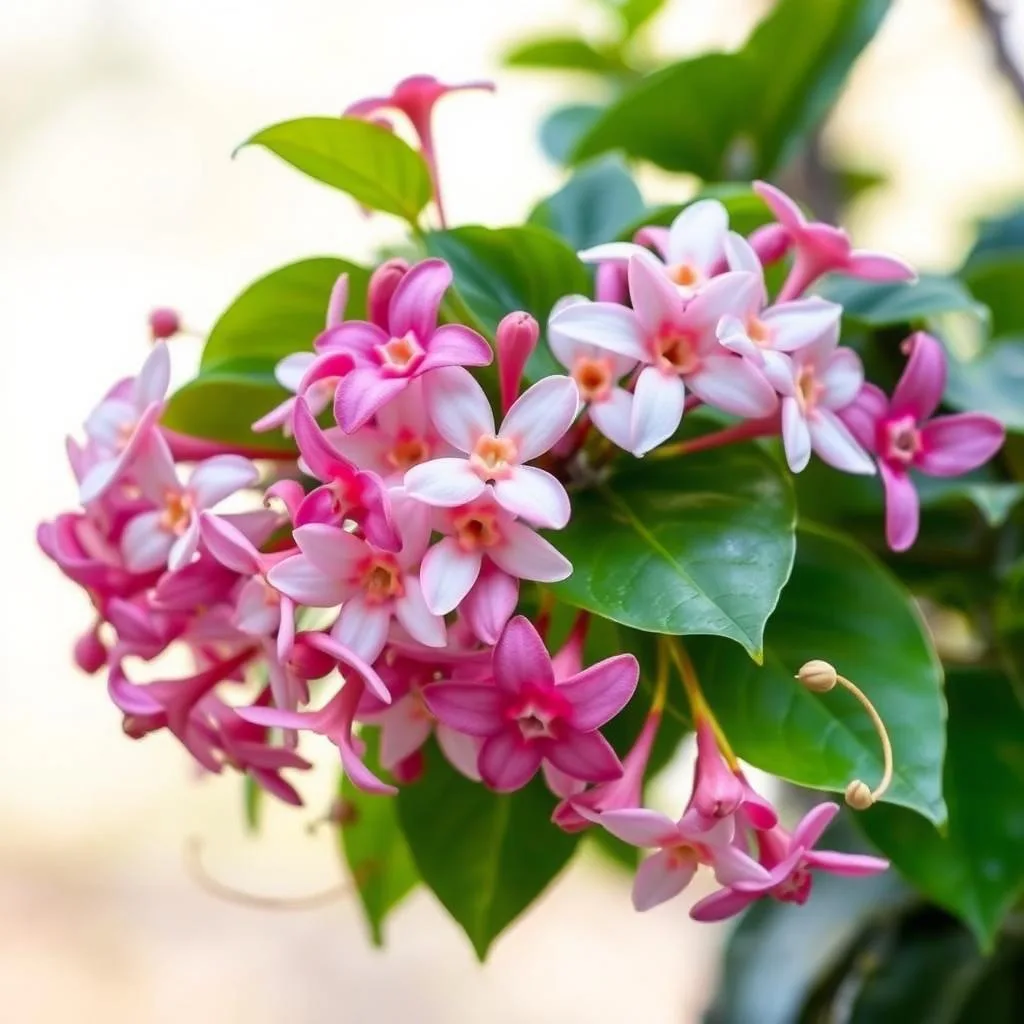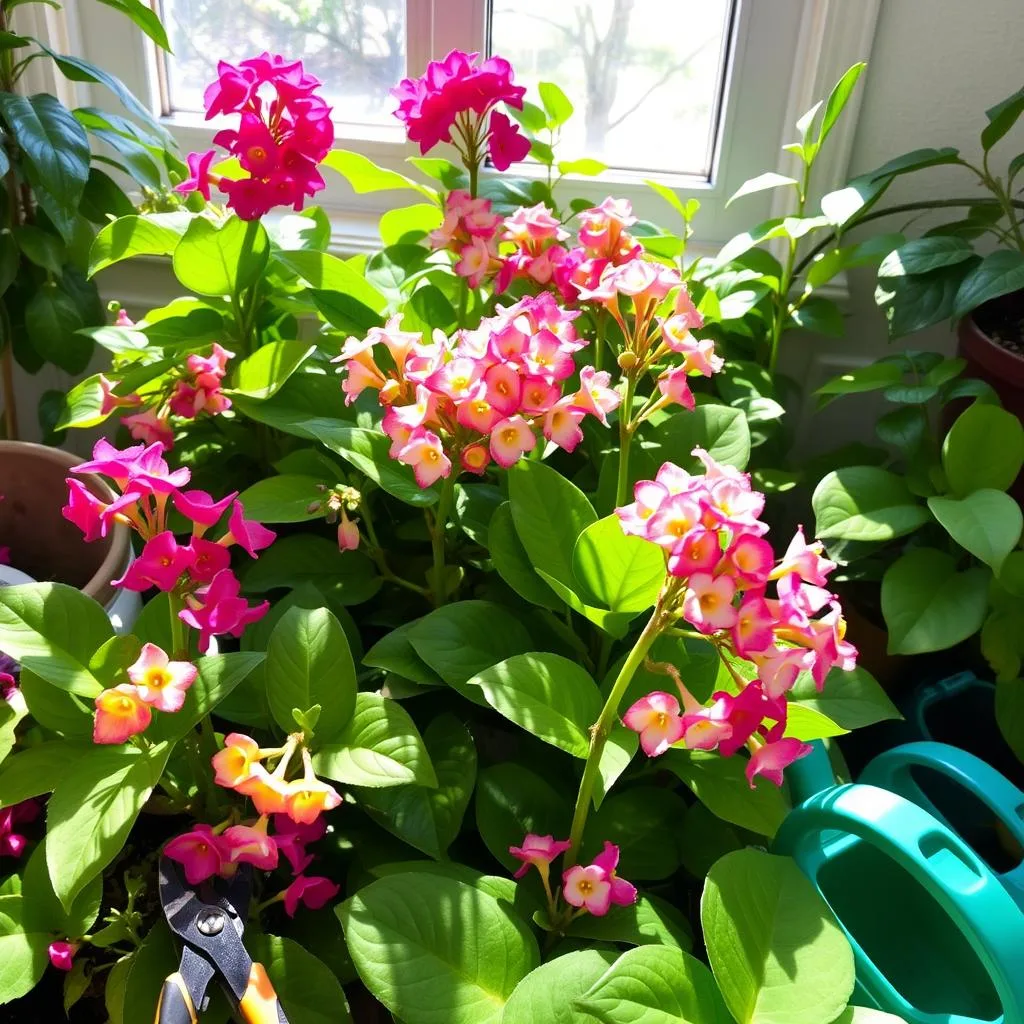Getting a Hoya bloom can be a bit of a challenge, but with the right care, it’s absolutely possible! To encourage blooming, start by providing your Hoya with the right light bright, indirect sunlight is key. Make sure your plant is in a warm, stable environment, ideally between 60-85°F (16-29°C). Hoyas bloom best when they’re a little root-bound, so avoid repotting too frequently. Regular watering is important, but let the soil dry out between waterings to prevent root rot. Additionally, consider feeding your plant with a balanced fertilizer during the growing season to promote healthy growth and blooming. Lastly, be patient, as Hoyas can take a few years to start flowering!
Key Takeaways
- Discover the allure of Hoya plants and their stunning floral displays.
- Learn the essential care requirements for healthy and vibrant Hoya plants.
- Explore techniques to encourage abundant and long-lasting Hoya blooms.
- Identify and troubleshoot common Hoya issues to ensure your plants thrive.
- Discover the diverse Hoya species and their unique bloom characteristics.
Introduction to Hoya Plants
Hoya plants, also known as “wax plants,” are fascinating. They are mostly tropical, evergreen vines and shrubs from Southeast Asia and Australia. These plants are loved for their thick, waxy leaves and beautiful, star-shaped flowers. These flowers can be white, pink, purple, or red.
What Are Hoya Plants?
Hoya plants are part of the Apocynaceae family. They are known for being tough and adaptable. They can grow well in many environments, making them great for indoor and outdoor gardens. People like them because they are easy to care for.
The Allure of Hoya Blooms
The real magic of Hoya plants is their lovely, fragrant flowers. These flowers are often called mesmerizing. They have a sweet smell that fills the air. These flowers can last for weeks, making gardens look beautiful and attracting bees and butterflies.
“Hoya blooms are a true wonder of nature, with their waxy petals and enchanting scent that can transport you to a tropical paradise.”
We will learn more about Hoya plants and their beautiful blooms in the next sections.

Hoya Bloom: A Mesmerizing Floral Spectacle
Hoya blooms are truly a sight to behold, captivating plant lovers with their detailed, waxy petals and sweet scent. The hoya bloom characteristics are visually stunning and intriguing. These flowers grow in clusters, with each bloom about 1-2 inches wide. As they open, they show a captivating, three-dimensional star-like shape that shines in the light, highlighting the hoya bloom beauty.
Hoya blooms are known for lasting weeks, adding to their charm and making them a treasured part of any plant collection. The hoya bloom description includes a delicate, waxy feel and vibrant colors, from pure white to deep pink or lavender.
“Hoya blooms are truly a horticultural marvel, combining intricate design with a mesmerizing display that captivates all who witness it.”
The sweet, almost honey-like scent of hoya blooms is another reason for their popularity. Many hoya species give off a sweet scent that can fill a room, delighting the senses. Whether shown alone or in a lush arrangement, hoya blooms showcase the beauty and variety of nature.
From their delicate, star-shaped petals to their long-lasting, waxy blooms, hoya flowers offer a captivating floral experience. With their unique hoya bloom description and mesmerizing hoya bloom beauty, it’s clear why hoya plants are a cherished and sought-after addition to many indoor plant collections.
Essential Care for Hoya Plants
To keep Hoya plants thriving, it’s key to know their light, temperature, watering, and humidity needs. By giving them the right conditions, your Hoya plants will flourish.
Light and Temperature Needs
Hoya plants love bright, indirect light. They can handle some direct sunlight but too much can burn their leaves. Place your Hoya in a spot with 4-6 hours of bright, indirect light daily.
They also like warm temperatures, between 65-85°F (18-29°C). Keep them away from sudden temperature changes or extreme cold. This helps them grow well.
Watering and Humidity Needs
Watering Hoya plants should be balanced. Let the soil dry out a bit before watering again. Water more often when they’re growing and less in winter.
Keep a regular watering schedule to avoid root rot. Hoya plants also do well in humid places. You can mist the leaves or use a pebble tray to keep humidity up.
| Hoya Care Factor | Optimal Conditions |
|---|---|
| Light | Bright, indirect light; 4-6 hours per day |
| Temperature | 65-85°F (18-29°C) |
| Watering | Allow soil to partially dry between waterings |
| Humidity | Maintain high humidity levels through misting or pebble trays |
Understanding and meeting the hoya plant care needs helps create a great environment. This supports their healthy growth and beautiful blooms.

Encouraging Hoya Blooms
I’ve learned the secrets to getting hoya plants to bloom beautifully. The key is in pruning and training them right. This can really increase their blooms. Let’s explore how to make your hoya plants bloom more and show off their beauty.
Pruning for Prolific Flowering
Pruning is key to getting more blooms from hoya plants. By cutting dead or damaged leaves, you help the plant focus on growing new, healthy parts. This leads to more hoya blooms. Always use sharp shears and cut just above a healthy leaf.
- Prune in early spring before new growth emerges
- Remove any dead or dying stems and leaves
- Trim back overly long vines to promote a more compact, bushy habit
- Avoid cutting more than one-third of the plant at a time
Training for Optimal Bloom Display
Training your hoya plants also helps them bloom more. By guiding their growth, you make sure they look great and bloom well. Use trellises or stakes to help them grow in a beautiful way.
- Gently tie vines to a trellis or stake as the plant grows
- Prune and pinch back wayward growth to maintain a desired shape
- Rotate the plant regularly to ensure even light exposure
- Consider propagating and training multiple hoya plants together for a lush, cascading effect
By pruning and training your hoya plants well, you’ll see their true beauty. With a bit of care, you’ll get a beautiful display that will impress everyone.
“Hoya plants are true divas of the plant world, and with the right hoya pruning and hoya training techniques, you can coax out their full flowering potential.”
Troubleshooting Common Hoya Issues
Hoya plants are easy to care for, but they can still face some problems. As a Hoya enthusiast, I’m here to help you solve the most common issues. This way, your Hoya can keep blooming beautifully.
One big problem is leaf discoloration. It can happen for many reasons, like wrong watering, not enough light, or not enough nutrients. To fix this, check how often you water your Hoya, make sure it gets enough sunlight, and think about using a balanced fertilizer.
- If leaves turn yellow, it might mean you’re watering too much or the soil drains poorly. Change your watering habits and let the soil dry out a bit between waters.
- Brown or crispy leaves suggest you’re not watering enough or the air is too dry. Try misting more or use a pebble tray to keep the air moist.
Bud drop, where buds fall off before opening, is another issue. It can be caused by sudden temperature changes, wrong watering, or not enough light. To stop this, keep the temperature steady, water when the soil is a bit dry, and make sure it gets enough light.
Poor flowering can be a letdown for Hoya lovers. It might be because your plant is too young, doesn’t get enough light, or wasn’t pruned right. Make sure your Hoya gets enough light, prune to encourage growth, and be patient. These plants take time to bloom fully.
By taking care of these common Hoya problems, you can keep your plant healthy and blooming well. Remember, every Hoya is different, so you might need to try a few things to find what works best. With some troubleshooting and love, your Hoya will keep amazing you.
Hoya Varieties and Their Unique Blooms
The Hoya genus is a diverse and captivating group of plants. It has over 200 species and countless cultivars. Each one has its own distinct characteristics. As we explore hoya varieties, get ready to be amazed by their beauty and variety.
Exploring Different Hoya Species
From the classic Hoya carnosa to the rare Hoya imperialis, the hoya species show a wide range of shapes, sizes, and colors. Some, like the Hoya pubicalyx, have intricate, star-shaped hoya bloom types. Others, such as the Hoya lanceolata, charm with their delicate, sweet-smelling flowers.
- Hoya carnosa: The quintessential Hoya, known for its thick, waxy leaves and clusters of pink, star-shaped blooms.
- Hoya imperialis: A rare and sought-after species, featuring large, purple-red flowers with a distinct, almost velvet-like texture.
- Hoya pubicalyx: Recognized for its eye-catching, star-shaped hoya bloom types that often display a captivating range of colors, from deep red to vibrant pink.
- Hoya lanceolata: A delicate and fragrant Hoya variety, adorned with delicate, bell-shaped flowers that release a sweet, intoxicating scent.
Exploring hoya varieties shows each species has its own charm. Whether it’s the intricate patterning of the Hoya bella or the vibrant colors of the Hoya macrophylla. Embrace the diversity of these plants and let their stunning blooms inspire your gardening.

Creating Stunning Floral Displays with Hoya Blooms
Hoya blooms are truly stunning, both on the plant and in arrangements. As a horticulturist, I’ve learned to highlight their beauty. This makes for eye-catching displays that wow your guests.
Arranging Hoya Blooms for Maximum Impact
For Hoya arrangements, focus on their natural beauty. Pick Hoya types that match in color and shape. Hoya carnosa and Hoya bella look great together, with pink and white blooms.
Place the Hoya flowers in a way that looks striking. Let them flow or group them in a bold design. Try different vase shapes and heights for depth. A clear glass or sleek ceramic vase is perfect for showing off the flowers.
Add other natural elements like greenery or petals to your arrangement. The aim is to make a display that celebrates Hoya blooms’ beauty.
“The true beauty of Hoya flowers lies in their delicate, waxy petals and their ability to bloom and captivate for weeks on end.”
Whether you’re a pro at floristry or just love gardening, learning about Hoya arrangements can improve your skills. With creativity and attention to detail, you can turn your Hoya blooms into stunning designs. These will surely impress everyone.
Hoya Bloom: A Symbol of Beauty and Resilience
Hoya blooms are more than just beautiful; they carry deep cultural and symbolic meanings. Throughout history, Hoya plants have been seen as symbols of resilience and longevity. They can grow well in tough conditions. The hoya bloom symbolism and hoya bloom meaning are celebrated worldwide, showing the lasting beauty and importance of these flowers.
In many Asian cultures, the Hoya bloom stands for love, devotion, and good luck. Its ability to survive and thrive in hard places makes it a symbol of perseverance. The hoya bloom cultural significance is seen in traditional art, literature, and ceremonies. It’s seen as a sign of strength and flexibility.
“The Hoya bloom is a testament to the power of nature’s resilience. Its delicate yet captivating appearance belies an inner strength that has been admired for generations.”
Botanists and horticulturists are also fascinated by the Hoya bloom. They study its unique structure and how long it lasts. This has inspired many people who want to learn more about these amazing plants.
When you grow and enjoy your Hoya blooms, think about their deeper meaning. They can symbolize love, resilience, or the lasting beauty of nature. The Hoya bloom is truly a treasure to see.
| Hoya Bloom Symbolism | Hoya Bloom Meaning | Hoya Bloom Cultural Significance |
|---|---|---|
| Love, Devotion, Good Fortune | Resilience, Longevity, Adaptability | Celebrated in Art, Literature, Ceremonies |
Conclusion
In this guide, we explored the secrets of growing Hoya bloom displays. We covered everything from Hoya plant characteristics to hoya plant care and growing tips. Now, you know how to make your own stunning Hoya floral displays at home or in the garden.
If you’re new to Hoya plants or already love them, I hope this guide has inspired you. It should help you make the most of your Hoya collection. Enjoy the beauty of their hoya bloom displays.
With the hoya bloom growing tips from this article, you’re ready to grow beautiful Hoya flowers. These plants can create stunning floral arrangements that will amaze everyone. With proper care, your Hoya plants will give you lots of blooms that seem magical.
Keep exploring with Hoya plants and try new things. Enjoy the process of Hoya cultivation. Seeing the Hoya bloom and feeling proud of your work is special. Let your love for Hoya plants grow. Let their beautiful blooms make your spaces more lovely.
FAQ
Hoya blooms are mesmerizing with their detailed, waxy petals and sweet scent. They grow in clusters, with each flower about 1-2 inches wide. As they open, they show a beautiful, three-dimensional star shape that sparkles in the light.
The flowers stay open for weeks, making them a treasured part of any plant collection.
For stunning Hoya blooms, give your plants the right conditions. They love bright, indirect light and temperatures between 60-80°F. They need regular water but not too much, and they do well in humid environments.
Knowing these key factors will help your Hoya plants bloom beautifully.
Hoya plants are easy to care for, but some techniques can boost their blooming. Pruning and training them can help. By trimming and training wisely, you can create the best conditions for lots of flowers.
Hoya plants are mostly easy to care for, but they might face some issues. Problems like leaf discoloration, bud drop, or not enough flowers can happen. By fixing these problems, you can keep your Hoya plants healthy and blooming well.
I’ll share tips and strategies to solve any issues you might face.
There are over 200 Hoya species and many cultivars, each with its own look. From the classic Hoya carnosa to the rare Hoya imperialis, there’s a lot of variety. Learning about these different Hoya types can be exciting for plant lovers.


1 thought on “Hoya Bloom: A Complete Guide to Flowering Success”
Comments are closed.